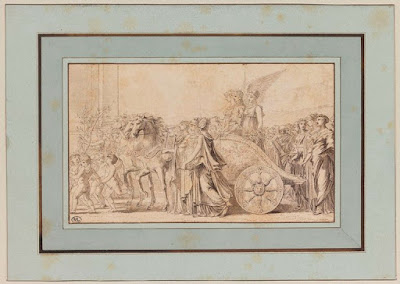 |
| Pierre-Paul Prud'hon Study for Portrait of the Empress Joséphine ca. 1805 drawing Musée du Louvre |
 |
| Pierre-Paul Prud'hon Portrait of the newborn King of Rome ca. 1811 drawing Musée du Louvre |
 |
| Pierre-Paul Prud'hon Triumph of Bonaparte as First Consul ca. 1801 drawing (print study) Musée du Louvre |
 |
| Pierre-Paul Prud'hon Fortune ca. 1780-1800 drawing (design for ornamental relief) Musée du Louvre |
 |
| Pierre-Paul Prud'hon Allegorical Figure of Painting ca. 1800-1805 drawing Musée du Louvre |
 |
| Pierre-Paul Prud'hon Allegorical Figure of Philosophy ca. 1798-1801 drawing (cartoon for wall painting) Musée du Louvre |
 |
| Pierre-Paul Prud'hon Genius of Philosophy ca. 1798-1801 drawing (cartoon for wall painting) Musée du Louvre |
 |
| Pierre-Paul Prud'hon Study for Genius of Liberty ca. 1791 drawing Musée du Louvre |
 |
| Pierre-Paul Prud'hon Figure Studies for The Dream of Happiness ca. 1819 drawing (study for painting) Musée du Louvre |
 |
| Pierre-Paul Prud'hon Académie ca. 1805 drawing Musée du Louvre |
 |
| Pierre-Paul Prud'hon Two Warriors ca. 1789-1801 drawing Musée du Louvre |
 |
| Pierre-Paul Prud'hon Sleeping Venus ca. 1806 drawing (study for painting) Musée du Louvre |
 |
| Pierre-Paul Prud'hon Venus and Adonis ca. 1812 drawing (study for painting) Musée du Louvre |
 |
| Pierre-Paul Prud'hon Académie ca. 1780-90 drawing Musée du Louvre |
 |
| Pierre-Paul Prud'hon Self Portrait ca. 1788-90 drawing Musée du Louvre |
"Born the tenth son of a stonecutter in Burgundy, Pierre Prudon altered both halves of his name and became Pierre-Paul Prud'hon, as if to relate himself to Peter Paul Rubens and to evoke landed gentry. He began studying painting in Dijon at age sixteen. He arrived in Paris in 1780, but his experience in Italy from 1784 to 1787, when he absorbed the softness and sensuality of Correggio's works and Leonardo da Vinci's sfumato, gave his art its distinctive style. Upon his return to Paris, Prud'hon enthusiastically supported the French Revolution. In 1801 Napoleon favored him with commissions for portraits, ceiling decorations, and allegorical paintings. "Prud'hon's true genius lay in allegory; this is his empire and his true domain," Eugène Delacroix later wrote. . . . Prud'hon's artistic style contrasted starkly with the dominant version of Neoclassicism under Jacques-Louis David. Prud'hon's paintings were based on classical texts and ancient prototypes, but his dreaminess and melancholy were more akin to Romanticism. His drawings, often black chalk on blue paper, were widely admired."
– from biographical notes at the Getty Museum, Los Angeles